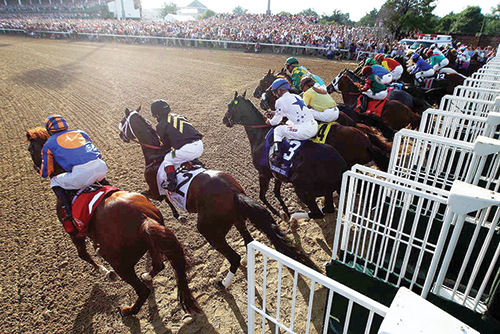
We are not far removed from a time when the horse was our primary form of transportation in the United States. Until the interstate highway system finally came to fruition in the 1950s—after decades of drawing and redrawing the lines across the map—a horse was often the most reliable way to get through the muck of many rural areas.
Yet we are still far enough removed that the allure of sprinting steeds fails to spark the imagination.
The public’s interest in horse racing has been waning over the past few decades. The sport’s last heyday came in the 1970s, when three horses won the Triple Crown over a six-year span. Since then, horse racing has tapered off into a prolonged decline in the public consciousness, and part of the problem has been the extended quest for one transcendent horse, an equine extraordinaire that could plow through the field at Churchill Downs, Pimlico and Belmont Park over a five-week stretch and immortalize his name alongside legends like Whirlaway, Citation and Secretariat.
But the Kentucky Derby has taken a different tactic this season that might revolutionize the sport of kings, using more relatable methods in selecting its 20-horse field. By linking a slew of preseason races before the Triple Crown stretch, Churchill Downs has taken the focus away from finding the next Seattle Slew and diverted it to their own version of NASCAR’s Chase for the Cup.
Formerly selected by an arcane system of graded stakes winnings at 185 different races around the country, the Derby Trail series now provides points for positioning at a series of 36 races, with the points available at each race increasing as the races become more prominent and the Derby draws closer. The system streamlines the selection process, making it easier for fans to follow along with which horses might be favored heading into May.
It also forces more top horses to square off as they vie for one of those 20 Derby posts. Until last season, you could have horses in various regions of the country racking up stakes winnings against obscure competition; now owners are forced to pit their top contenders against one another as they fight it out for points, increasing the level of competition at each track in the series. For a sport that has too long lacked a cohesive national governing body, relying instead on a set of divergent regulations on track operations from state to state, we are finally witnessing a more unified strategy in the Derby Trail.
Will there be another Triple Crown winner? Odds dictate that another horse will eventually come along that can qualify for Kentucky, get on a hot streak that continues to Maryland, and then steal the accolades in New York. When it will happen is another question entirely, since Triple Crown victories have tended to be defined more by the gaps in between than the conquest itself.
It took 44 years after the inaugural Kentucky Derby in 1875 for Sir Barton to become the first horse to win the treble. And while we tend to think of the sustained runs of kismet that saw four Triple Crown winners in the 1940s and the trio that ran in the 1970s, we often gloss over the 25-year drought between those eras.
It will always be fun to follow the field and wonder which horses might have a chance to break through as the next Triple Crown legend. As we enter the 35th season since Affirmed outraced Alydar three times for the most recent Crown, we enter into a new era of the sport. And as we wait for those stars to align again, the Derby Trail series brings horse racing back into focus, with a shift away from the speculative hope of years past and a return to the competition that will hopefully keep people coming back to the track for generations to come.

